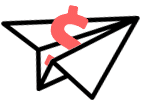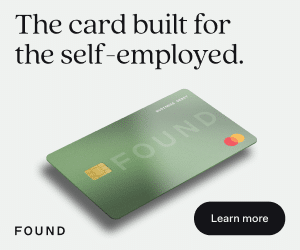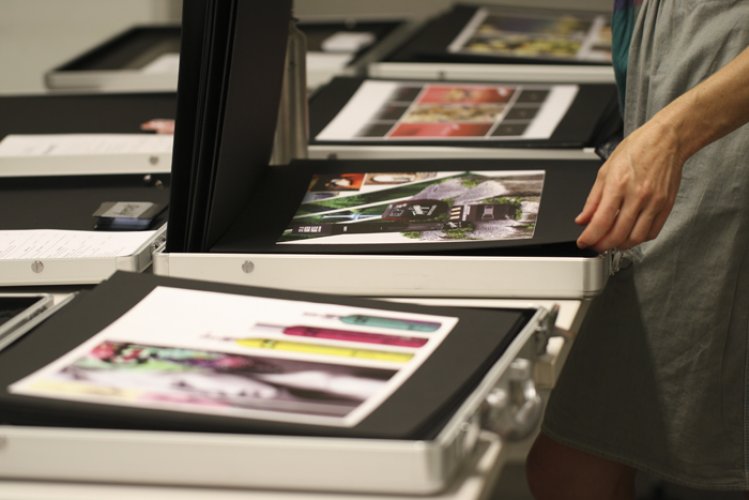A picture is worth 1,000 words.
Keep that in mind when you go to your next potential client meeting. You want to make a great first impression and win the account. While what you say and how you act are very important, ultimately, the client wants to know that you can deliver.
However, you’re probably not the only freelancer your client is interviewing. You need to wow them, and you can do it with your portfolio – and your accompanying presentation.

Get Weekly Freelance Gigs via Email
Enter your freelancing address and we'll send you a FREE curated list of freelance jobs in your top category every week.
What you’ll need:
- Portfolio binder/case (found either online or at your local art supplies store)
- Projects!
- Adhesive (tape, rubber cement, etc.)
My simple, black zippered portfolio – purchased at Michael’s – holds pieces up to 14×20. Since many of my projects are multiple smaller pieces, I used painter’s tape to secure them to the backing material semi-permanently. This allows me to customize my portfolio for the client I’m meeting.
There are also a million ways to build a physical portfolio. This is just one option. Share how you build your portfolio with us by leaving a comment.
Order matters
Put your most impressive piece first to wow them right from the get-go. Put another premier piece at the end of your portfolio to leave a great final impression. Then order the less exciting pieces in the middle.
You may choose to order your middle projects chronologically, by project type, by client/job, by layout, or simply by an order that flows nicely.
I always start with my infographic resume (and it’s always a big hit), and I put all of my landscape projects together so I minimize the amount of times I have to turn my portfolio.
Include projects with stories
If your potential client is considering several freelancers, chances are more than one of them are going to have really nice portfolios.
What separates you from the pack?
Why should they pick you?
That’s why you need to include projects with stories to show that not only can you create great work, you can think critically about how to best meet your clients’ needs.
When I present my portfolio, I showcase a cost-effective, 2-color product label design as well as a brochure that I worked directly with press operators on to perfect flesh-tones.
Choose projects they want to see…and you want to show off
Know what your potential client is looking for – if they’re considering hiring you for a logo, for example, bring samples of other logos (if you can).
But don’t pigeon-hole yourself by only showing what they want to see – add some additional projects that complement their needs. You might be able to up-sell them later.
Have you ever heard, “You can do <insert design project here>, too?! Wow, that’s great, because we need…”? Me, too.
It might seem obvious to you, but many clients don’t realize freelancers can handle a variety of projects.

My portfolio projects range from packaging to infographics to zoo posters to newsletters to a published writing sample to order forms. This shows that I’m a well-rounded designer who can take care of the majority of their needs.
Put something in their hands
It’s all fine and great to have your potential clients observe your projects, but bring extras that clients can touch and inspect, especially if they’re double-sided or folded. This helps engage multiple senses as well as that person at the far end of the table, increasing the likelihood that they’ll remember you.
I bring extra brochures, postcards, and invitations to pass out while I’m speaking about them. I also bring props – the actual bottles the packaging labels fit on as well as buttons that go with a promotional campaign.
Perfect your presentation pitch
Presentation matters.
Practice showing your portfolio to your spouse, roommate, best friend, or favorite pet. Explain each piece, timing yourself from start to finish.
Your entire presentation should take no more than 10-15 minutes. Don’t forget to include time for questions here and there.
Finally, don’t be afraid to show pride in your work. This is your very best work, so it’s okay to be excited about it.

What doesn’t belong in your portfolio
While there are exceptions to these guidelines, it’s best to avoid the following:
- Personal work. Clients want to see real-world solutions (student work is fine if you’re just starting out, but you should start to phase out everything but the most impressive as you finish client work).
- Software specifications. Unless they ask or it’s something special, your potential clients probably don’t care what software you used. Make a general statement like “I work primarily in the Adobe Creative Suite,” and share something more interesting.
Don’t underestimate the value of a killer physical portfolio!
True stories:
- In one interview, my client told me to stop halfway through showing my portfolio because he was so impressed he didn’t need to see any more.
- In another, the client told me my portfolio presentation won me the account. (And I don’t have the fanciest, most expensive portfolio!)
Has your portfolio impressed a potential client and won the account? Tell us about it! Leave a comment on this post and share your tips and stories about how you create and present your physical portfolio.

Keep the conversation going...
Over 10,000 of us are having daily conversations over in our free Facebook group and we'd love to see you there. Join us!




After 10 years with my employer, I find myself back on the job market. I still have the portfolio/binder I used to display my work when I interviewed for this current position; and it is in great condition. After 10 years, I have plenty of new projects to use to update my portfolio.
In researching current physical portfolio trends, I noticed a number of examples where the designer has photographed their work and used the photos to create a totally separate piece to represent their portfolio, rather than putting actual printed samples into a portfolio/binder. Some of these projects are quite elaborate and, I imagine, expensive to produce. Do you recommend following this trend (keep in mind finances will be tight), or continuing to display the actually printed pieces in my trusty portfolio/binder. Personally, I believe it is better to show prospective employers the actual printed piece so they can see the paper used as well as the quality of the printing, and feel the physical item in their hands, as apposed to flipping through a book that has photographs of the items in it. Your thoughts?
Hey April,
Glad to see someone shedding light on this (very useful) method to land clients/accounts! The whole time reading, I couldn’t help but make MadMen references throughout, haha!
I think it’s safe to say; the community would love to take a look at any photos of your physical portfolio.
Cheers!
This is a great post! I used to design interactive portfolio’s in Flash! Users usually finds it easy and fun. It also makes them stay longer on the site, when you have effects and things that people like!
I use a combination of a digital and physical portfolio. I once thought an iPad was enough but clients definitely need to touch and see the design. I recommend printing a strong piece of yours or designing something specifically to leave with the client. Cup holders or something small will help them remember you.
Steven – great idea!
What makes the difference between a killer portfolio and a simple portfolio is the enthusiasm and the endeavor to showcase your very best to client. Do not treat them lightly. And of course, do not shy to show the feedbacks if you have got from other clients.
Hi,
I just want u to know how I apprciate your posting , they are educative and informative to me and some other freelancers in my country who depends solely as a graphic artist freelancer.
Pls keep it up.
Funnily, I’ve included both “personal work” and software specifications in my physical portfolio, but I’ve always thought I’ve had a reason for this. Those personal pieces are actually (open) design contest entries (which I always mention in the description) but they don’t differ from client work all that much. There’s always been a “client” too, and a project brief, so I haven’t exactly been doing whatever I want. On the other hand I haven’t exactly done similar projects to real clients, so basically those examples broaden my design repertoire. I also think most of them are much more interesting than many other projects I’ve carried out… (And I only have a few years’ worth of work experience.)
However, I’ve also read professionals advise fellow designers to create fake design projects (ie. personal work, not to be falsely presented as actual client work) for their portfolio if their client base has been very homogeneous – just to prove they can handle various different styles.
As for the software specifications in my portfolio, I happen to show it to other designers (=potential clients/employers too!) quite often as well, and since they often ask anyway, I’ve included that desired information.
Laura,
If those things work for you, that’s great (there are always exceptions to every rule).
Thanks for sharing!
Great article, thank you! You asked “Has your portfolio impressed a potential client and won the account?” I can give you tips and advice on how to avoid a catastrophe and not land the account.
The interview went so well, he didn’t even request to see my portfolio, even though he asked me to bring it. So after an hour and a half interview was wrapping up, I asked if he wanted to see any of my work. I took out my 3 year old portfolio from my case and laid it in front of him. When he opened it up, I saw his face go “WOW!”. not from what he saw. From what he smelt. It was stored in a cupboard in a room that was smoked in very frequently. It had a strong stale ashtray aroma that blasted him right in his face.
I never did hear from him again. – FYI. My lesson – Keep your portfolio fresh!
Yikes!!! Do open your portfolio prior to your meeting and make sure cigarette smoke is NOT part of your portfolio!
Thanks for writing such a great piece on this subject. Your idea about grouping landscape and portrait pieces with each other seems like a great way to make a portfolio more accessible. Keep up the good work!
Thanks, Chris! I find it’s less jarring for everyone.
My prospective clients always view my portfolio via my website prior to meeting with me, so having a physical portfolio never really seemed important. I suppose it can’t hurt though. Seeing something in print is more impressive in my opinion. It also shows that you know how to take something digital and create a good looking print.
Derek,
Print is also more memorable. Sure, they looked at your portfolio before, but do they remember it? They probably looked at several or many.
Bringing a portfolio also shows that you take time and effort to prepare for the meeting, and that you take pride in your work.
More than 10 or 12 pages and the pitchee will glaze over and you’ve lost them. Remove the extra blank pages from your binder. Have a binder with pockets for magazines, catalogs, or anything with many pages so you are not turning a heavy, awkward page.
Karen,
Great points! Thanks for sharing!
Good post – what about for web designers who have a web-based portfolio? Would you recommend bringing a tablet with best work example still shots, or…?
Debbie,
A tablet is very useful – I use one to show my digital portfolio (I use still shots, too).
I often wondered if mine was rubbish etc when I wasnt getting jobs. Of course you get fobbed off with, to much experience, to little etc.
I used to just have all my work loose and rattling around inside. Seen as it was all brochures and stuff with pages. I couldnt think of another way of holding it all down.
Sounds like I made a mistake
Steve,
Presentation and organization are everything. Since you have a lot of little pieces, consider a small portfolio. Or use painter’s tape (for a temporary hold) to attach small pieces in a nice arrangement on a larger page. Or, keep them separate and show them outside of your portfolio but during your portfolio presentation.
Good luck!